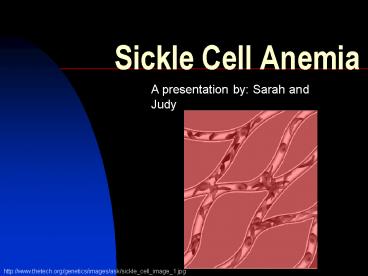Sickle Cell Anemia - PowerPoint PPT Presentation
1 / 16
Title:
Sickle Cell Anemia
Description:
A homozygous recessive genetic disorder, but may effect ... Splenomegaly, enlargement of the spleen (if ruptured will cause severe internal bleeding) ... – PowerPoint PPT presentation
Number of Views:675
Avg rating:3.0/5.0
Title: Sickle Cell Anemia
1
Sickle Cell Anemia
- A presentation by Sarah and Judy
http//www.thetech.org/genetics/images/ask/sickle_
cell_image_1.jpg
2
What is Sickle Cell Anemia?
- An inherited blood disease
- Affects red blood cells
- A homozygous recessive genetic disorder, but may
effect heterozygotes under extreme physical
stress or under high altitudes
3
An Inherited Trait
http//www.nhlbi.nih.gov/health/dci/Diseases/Sca/S
CA_Causes.html
4
Sickle Cell Factoids
- In the United States, sickle cell anemia affects
about 72,000 people. The families of most of the
people affected come from Africa - About 2 million Americans carry the sickle cell
trait. About 1 in 12 African Americans have the
trait
5
Normal Histology
- Red blood cells are usually smooth edged and have
a biconcave doughnut shape - They last about 120 days in the blood stream
before being taken out of circulation - Hemoglobin, an oxygen-carrier protein, is found
in red blood cells - It is made up of 4 globin chains (2 alpha and 2
beta)
6
Red Blood Cells
www-medlib.med.utah.edu/ WebPath/jpeg5/HEME002.jpg
7
Disease State, What Happens?
- Causes a sickling shape via a mutation in beta
globin - Hydrophobic patches are created on deoxygenated
hemoglobin - These patches stick to one another causing it to
aggregate into chains - Causing the observed sickle shape
- This abnormal shape impedes blood flow in small
vessels - Can cause pain, damage, and a low blood count
(anemia)
http//www.mcg.edu/centers/sicklecell/images/2017.
jpg
8
Sickle Cells
http//www.thedoctorwillseeyounow.com/articles/oth
er/sicklecell_3/sickle1a.gif
9
Sickle Cells
http//www-medlib.med.utah.edu/WebPath/jpeg5/HEME0
15.jpg http//webanatomy.net/histology/blood/sickl
e_cells.jpg
10
Possible Outcome
- Splenomegaly, enlargement of the spleen (if
ruptured will cause severe internal bleeding) - The spleen is an organ involved in the production
and maintenance of red blood cells, the
production of certain circulating white blood
cells, and is a part of the lymph system and the
immune system - Because of its wide variety of functions, the
spleen may be affected by many conditions
involving the blood or lymph system - Can be caused by sickle cells filling the red
pulp and causing the spleen to expand
http//www.brown.edu/Courses/Digital_Path/Spleen/s
ickle_cell_anemia_2.JPG
11
Other Possible Outcomes
- Infections
- Infants and young children are more susceptible
to bacterial infections (ex meningitis) - Pain Episodes
- Blockage of blood flow in joints, muscles, etc
- Can be mild to severe
- Stroke
- Occurs when blockage occurs in the brain
12
Treatments
- General Treatment
- The goal of treatment is to relieve pain,
prevent infections, and control complications if
they occur - Treatments include medications, blood
transfusions, and specific treatments for
complications - Bone marrow transplant
- Will provide new normal stem cells
- Because all blood cells arise from stem cells,
providing the person with normal stem cells will
assist in their production of normal red blood
cells
13
Benefit?
- Being a carrier for this disease is beneficial in
some parts of the world - Where malaria is prevalent, being a carrier
creates a resistance to the deadly disease - Individuals who are heterozygous for the sickle
cell trait (carriers) are selected for in this
environment - When a heterozygous individuals RBC becomes
infected with the malaria parasite, the cell
sickles and will be caught and destroyed in the
spleen
14
Concluding Remarks
- An inherited trait, not infectious
- Sickle caused by abnormal heme group
- Treatment possible, research for cure ongoing
- Homozygous individuals are unfit, heterozygous
individuals have advantage only in environments
with malaria risk
15
Video
Video 2 Sickle Cell Mouse (Non-Transplanted)
http//www.mssm.edu/labs/frenette/sickle_pnas.shtm
l
16
References
- Ross, et al. Histology A Text and Atlas 4th ed.
2003, Ch 9. - http//www.nlm.nih.gov/medlineplus/sicklecellanemi
a.html Nov. 21, 2005 - http//www.nhlbi.nih.gov/health/dci/Diseases/Sca/S
CA_WhatIs.html Nov. 21, 2005 - http//www.sicklecelldisease.org/about_scd/faqs.ph
tml Nov. 21, 2005 - http//www.sicklecelldisease.org/ Nov. 21, 2005

